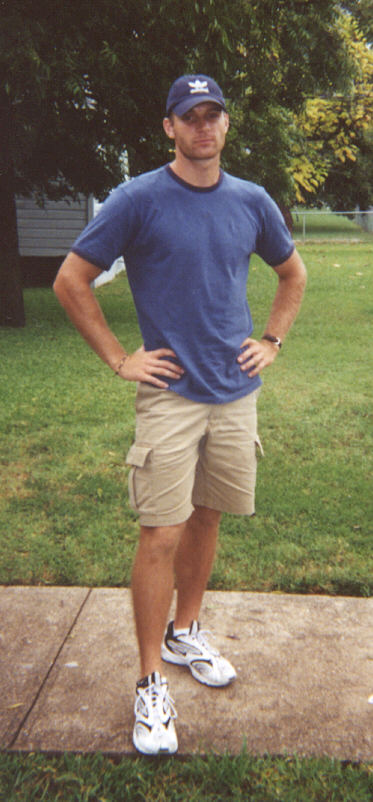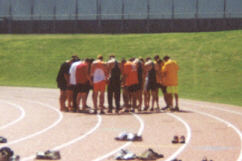
|

|
|
Erik Sienty--Man of Integrity
|
 Erik in his front yard in Commerce
Erik in his front yard in Commerce
|
Erik's passion is Jesus Christ, but the Lord has given him passion and ability to be a world class athlete.
His integrity is seen by those who meet Erik on campus, church, or in the community. As a Christian, Erik strives to make choices and act as Christ would, thus giving him the description of a "Man of Integrity."
"I am working real hard on improving my skills. If it is God's will for me to make it to the Olympics then I'll be there in 2004." This is what Erik said in 2003 after he graduated from Texas A&M University-Commerce, but he did not know that his destiny lied elsewhere.
Below is an article written about Erik during the spring semester at the university in 2003.
Commerce Senior Bound for Greek Games
Erik Sienty, senior at Texas A&M University-Commerce, is training to compete in the 2004 Olympic games to be held in Athens, Greece. He is a decathlete. Unlike track and field athletes, decathletes compete in both types of events instead of having a specialty. They are known as well-rounded athletes because of their skill and ability.
Though he has completed a four-year season with the university track and field team, Sienty saw a bigger dream and is perusing it. He trains at least four hours everyday at Lion Memorial Stadium and in the temporary recreation center facility. He uses the athlete weight room from time to time and occasionally drives to other universities to train with their athletes.
Sienty' s dedication can be seen in his daily routine. He stays focused on his goal by choosing to not drink or smoke and very rarely stays out late, even on the weekends. His food intake consists of only healthy foods such as grilled chicken, tuna, bran, juices, and soymilk.
" Last year I climbed 200 points, said Sienty when asked about his progress. He needs 700 more to qualify for the trials," Sienty explained. The Olympic trials determine who will represent the United States in the games. He said, " The trials eliminate the good from the great. "
Even though he is not training and competing this year with the A&M Commerce track and field team, Sienty will continue to train and compete on his own at the very same competitions as he presses on to earn enough points for the Olympic trials.
|
A decathlon is a two-day miniature track meet designed to ascertain the sport's best all-around athlete. Within its competitive rules, each athlete must sprint for 100 meters, long jump, heave a 16-pound shotput, high jump and run 400 meters -- all in that very order -- on the first day. On the second day the athlete runs a 110 meter hurdle race over 42 inch barriers, hurls the discus, pole vaults, tosses a javelin and, at the end of the contest, races over 1500 meters, virtually a mile.
A decathlon is the most neighborly of all track events. Because the same athletes are together for the better part of two days and the rules require a minimum of 30 minutes rest between events there is much time to chat on the field. And much of the time is used in helping one another, appraising technique, verifying takeoff points, giving advice and reassurance, even using others' equipment.
|
 Decathletes pray before the events begin--San Angelo State University 2002
Decathletes pray before the events begin--San Angelo State University 2002
|
So what are the different events in a decathlon?
DAY ONE
100 METERS This event measures basic leg speed and each race/heat will have between 3 and 8 runners. You will push off a set of starting blocks at the start as a reaction to a starters pistol, sprint for 100 meters and lean at the finish line. The race can be timed with a hand held stopwatch to the tenth of a second, or by an automatic timing device which will catch the runners in 1/100ths of a second.
LONG JUMP The athlete runs toward the landing area, plants his takeoff foot on an 8-inch 'toeboard' (named for obvious reasons) and leaps into a sand filled pit. The distance is measured from the mark made in the pit which is closest to the takeoff board. Speed and accuracy are secondary to leaping ability. Each athlete will have only 3 chances and only the best jump will count in the scoring.
SHOT PUT The shot put measures basic arm strength. Again, three tries counting only the best effort for scoring. The athlete attempts to push or 'put' (not throw) a 16-pound iron ball so that it lands within a sector of 40 degrees. The throwing circle is seven feet wide and made of concrete. Efforts do not count if the athlete oversteps the throwing circle or if the shot lands outside of the sector lines.
HIGH JUMP Yet another explosive event where the athlete must approach the bar and landing area, gather himself and leap (always off one foot) over a crossbar. The landing pit is usually made of foam rubber. The crossbar is raised, usually 3cm (@ 1 1/4inches) and an athlete is eliminated after three consecutive misses. The highest height cleared is used for scoring.
400 METERS A century ago, a quarter mile (440 yards) race was deemed an endurance test. Today its metric equivalent is almost an all out sprint. The athlete runs the entire distance in lanes, and like the 100 meter race, may have anywhere from 2 to 7 competitors. The 400 meters tests both speed and stamina and ends the first day's competition.
DAY TWO
110-METER HURDLES The initial event of the second day combines speed and agility. The athletes must sprint (not jump) over a series of ten barriers, 42 inches high (39 inches at the high school level), which are placed 10 yards apart. The athlete must both sprint and stretch his stride pattern so as to only take 3 steps between hurdles. Hurdles may not be deliberately knocked down.
DISCUS THROW The discus, which weighs 2 kilograms (4 1/2 pounds) and is 8'2.5" inches in diameter, has aerodynamic qualities. Again, only three tries are allowed and the athlete, while turning 1 1/2 times, must stay within an 8'2.5" concrete circle. The discus must land within a 40-degree sector. Only the best throw counts in the scoring.
POLE VAULT Technically this is the decathlon's most difficult event. While grasping the upper end of a 14 to 15 foot fiberglass vaulting pole, the athlete races toward the pit, plants the pole in a takeoff box and swings himself up and over a crossbar, eventually landing in a foam rubber pit. Sound easy? It takes lots of practice.
JAVELIN The javelin is a metal spear approximately 8½ feet in length and weighing 800 grams (just under 2 pounds). It must be held by a grip and the throw made behind an arc. At all levels except the high school the javelin must land point first within the sector, which is 29 degrees wide. Each athlete is given three attempts and the best throw is scored.
1500 METERS The final test is one of endurance, 3 3/4 laps around the 400-meter track. Rarely does the decathlete have the luxury of loafing during this event since. He must give his best effort since, at approximately 6 points for every second, places, scores and records (personal or otherwise) will be at stake.
|
|